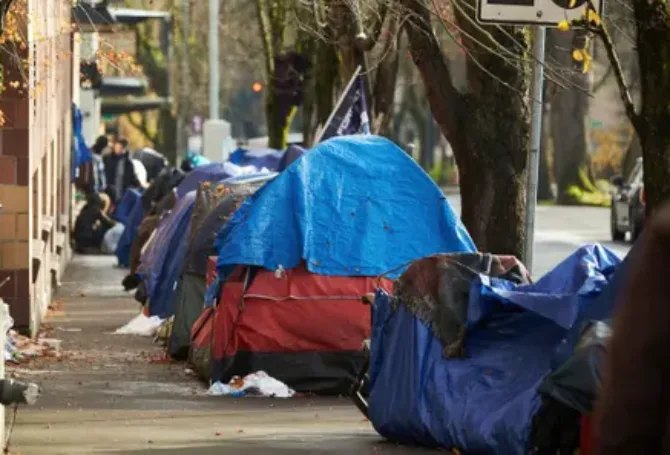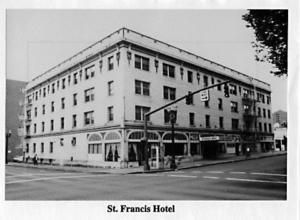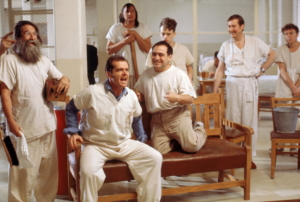
Loss of Low-Income Housing, Mental Health Beds Left People on the Street
Destruction of low-income downtown housing in the 1960s and closure of state psychiatric facilities in the 1980s laid the groundwork for Portland’s current-day homelessness. Growing levels of drug addiction turned a serious challenge into an emergency.
Building more affordable housing and bolstering mental health and addiction treatment services are obvious responses but not easy ones to accomplish, especially in light of how we got to this point and the interlocking actions that will be required to overcome the emergency.
 In a two-part series posted last week, OPB reporter Alex Zielinski traces the origins of homelessness in Portland and explores potential solutions. The reports are part of a year-long deep look into social and economic challenges facing Oregon.
In a two-part series posted last week, OPB reporter Alex Zielinski traces the origins of homelessness in Portland and explores potential solutions. The reports are part of a year-long deep look into social and economic challenges facing Oregon.
Unbuilding Blocks of Homelessness
Zielinski goes back to the late 19th century when Portland relied on migrants as for low-wage manual labor in warehouses and on the docks. To house this workforce, the City built short-term lodging, which evolved into single-room occupancy hotels (SROs). “These hotels offered single rooms for around 35 cents a night ($12 in 2023 rates) with communal kitchens and bathrooms,” Zielinski reported.
 Over time, many of the workers became permanent residents and secured homes. The SROs became “permanent rest stops for the poorest Portlanders”. In the 1950s and 1960s, as part of a succession of urban renewal and highway construction projects, housing for the poor and minority neighborhoods was leveled and replaced with higher-end housing and business districts. Zielinski cites a Northwest Pilot Project indicating more than 2,000 SROs in Portland disappeared between 1978 and 2015.
Over time, many of the workers became permanent residents and secured homes. The SROs became “permanent rest stops for the poorest Portlanders”. In the 1950s and 1960s, as part of a succession of urban renewal and highway construction projects, housing for the poor and minority neighborhoods was leveled and replaced with higher-end housing and business districts. Zielinski cites a Northwest Pilot Project indicating more than 2,000 SROs in Portland disappeared between 1978 and 2015.
In 1968, Congress adopted the House and Urban Development Act to help low-income Americans buy homes with affordable mortgages or rent housing with financial assistance. Five years later, President Nixon imposed a moratorium on all public housing expenditures. Cutbacks in social service programs for low-income Americans and a pair of recessions laid the groundwork for perpetual housing and social service shortages.
Loss of public affordable housing units became a through-line to shelters. Central City Concern was formed in 1979 to preserve remaining SROs and deal with a growing number of homeless people addicted to alcohol living on the streets.
 “Community” Mental Health
“Community” Mental Health
The number of homeless people living on the street increased after state officials shut down large psychiatric facilities and poor farms following reports of inhumane treatment, which inspired Ken Kesey’s One Flew Over the Cuckoo’s Nestfilmed at Oregon State Hospital.
It quickly became obvious that promised community mental health services were inadequate or didn’t exist. Now people suffering from a variety of mental illnesses were left to fend for themselves and manage their own medication. An early community mental health provider in the Burnside area of downtown employed caseworkers who assisted homeless people with medication management.
The Heroin Epidemic
The mix of poor, jobless and mentally ill homeless people expanded with the onset of a heroin epidemic, often resulting from abuse of pain medication for a serious injury or medical condition.
The 1990s also saw a surge in Black homelessness due to gentrification of historically Black neighborhoods and the War on Drugs that disproportionately incarcerated Black people, leaving them without jobs, splintering their families and cutting them off from churches and other supportive communities. At the time, many homeless shelters at the time were run by religious groups that adopted zero-tolerance policies for drug addicts.
Portland’s population grew by 100,000 people between 2005 and 2015. New housing didn’t keep pace.
In-migration Fuels Price Hikes
Providers such as Central City Concern managed to hold down persistent street homelessness because of a slack housing market that provided places to rent at affordable prices. Vacancy rates started to decline as early as 2005 when Portland’s population ballooned. Zielinski noted Portland’s population grew by 100,000 people between 2005 and 2015. New housing didn’t keep pace, which spiked the cost of housing to buy or rent.
Portland’s homelessness problem began to spill over to other cities. On the Oregon Coast, once affordable housing was converted into vacation rentals. Few communities saw new housing match growing demand, especially after the 2008 recession. Oregon state economists say Oregon needs 140,000 housing units to meet current demand.
Limited housing inventories have contributed to Oregon becoming one of the states with the lowest supply of housing that people earning at or below the poverty line can afford. An injury or serious illness causing lost income can result in someone reduced to living in their car.
Largest Cause of Homelessness
People can experience housing insecurity because of mental health, drug addiction, PTSD, low income or domestic abuse. However, economists say the closest correlation with homelessness is to a shortage of housing, especially a shortage of affordable housing.
 “If you simply look across the country and see where rates of homelessness are the highest, they’re in the parts of the country that have allowed their housing markets to overheat,” explains John Tapogna, senior policy analyst at ECONorthwest.
“If you simply look across the country and see where rates of homelessness are the highest, they’re in the parts of the country that have allowed their housing markets to overheat,” explains John Tapogna, senior policy analyst at ECONorthwest.
Zielinski reported cities like Detroit and Philadelphia with high poverty rates have some of the lowest homelessness rates in the nation. West Virginia ranks highest in drug overdoses with one of the smallest homeless populations.
“Permanent supportive housing serves people on a deeper level and gets to the root cause of homelessness.”
 Supportive Housing
Supportive Housing
Increasing housing supply will relieve over time pressure on rent increases. For the thousands of Oregonians without housing, that’s not reassuring they can escape homelessness any time soon.
One of the most promises antidotes to homelessness is supportive housing – housing that is affordable with wraparound services that address a variety of needs of homeless people. A core component of supportive housing is housing without a clock, which gives a person or a family the time they need to get their feet on the ground. In return for a roof over their head and access to services, supportive housing tenants are encouraged – not forced – to participate in services to the community.
Supportive housing can be apartment units designed to house formerly homeless people, affordable housing units for people with rent subsidies or designated housing units in larger complexes. The concept is to re-introduce homeless people to homes and surround them with services to re-establish their lives, whether it’s job training, addiction treatment or medication management.
As Zielinski reports in the second part of her series, studies show supportive housing works: “Permanent supportive housing is a relatively new approach to ending homelessness. It grew out of a widespread solution to homelessness called ‘housing first,’ which prioritizes moving unhoused people into housing before addressing other needs. After research found that housing alone isn’t enough to end homelessness, governments began investing in programs that partner housing with hands-on support.”
“Permanent supportive housing is the opportunity to serve people on a deeper level and get to the root cause of some of the issues,” says Leor Beverly, a housing program manager at the Urban League of Portland that provides supportive housing. “We address the trauma, we address the damages, and it’s a place for people to feel safe.”
Like many good things, supportive housing is expensive. Multnomah County reported spending about $14.8 million to place 934 people into permanent supportive housing between August 2022 and August 2023. The cost is offset in part by reductions in hospital stays, use of mental health services and arrests.
Another challenge for supportive housing is that might not be as temporary as government officials would prefer. To move on to regular housing, people would need to have the income to afford the rent and utilities. That translates into fewer people being helped.
 Interim Steps to Housing
Interim Steps to Housing
Not everyone is ready to move directly from a tent beneath an underpass to a furnished apartment. A transitional step can be shelter programs such as Opportunity Village that offer pods with access to laundry, showers and a communal kitchen. Think SROs in metal pods. A related transitional option are safe rest villages, individual units in a cluster.
Whether pods or apartments, date suggests that getting people off the street into something with a roof appears to a successful formula to combat homelessness. A variety of support systems and belonging to a community activate in people a sense of hope and hope.
Supportive housing and transitional housing take time to build, requiring something better and safer than camping under bridges. The idea of sanctioned city encampments has been proposed as an interim measure. Critics say large camps can produce safety and health challenges for the occupants and surrounding areas.
 Addiction Treatment Critical
Addiction Treatment Critical
Ed Blackburn, the long-time former director of Central City Concern, warns that housing, even with wraparound services, won’t be enough to curb homelessness and street drug use for people suffering from substance abuse. He says addiction recovery programs and mental health care are critical.
As the rising number of drug overdoses suggests, addiction treatment, drug awareness and wide access to Naloxone that reverses overdoses are critical but remain inadequate in large part because of a lack of trained behavioral health professions.
The public, at least according to polling, is disenchanted with Measure 110 drug decriminalization. If repealed, as an initiative will propose, addicts could find themselves under the roof of jails. Putting more people in jail for drug possession may not be the solution some people seek because of another severe shortage – public defenders




